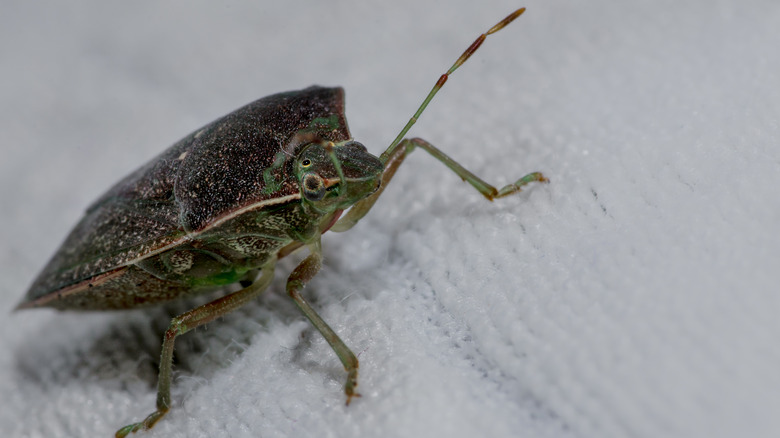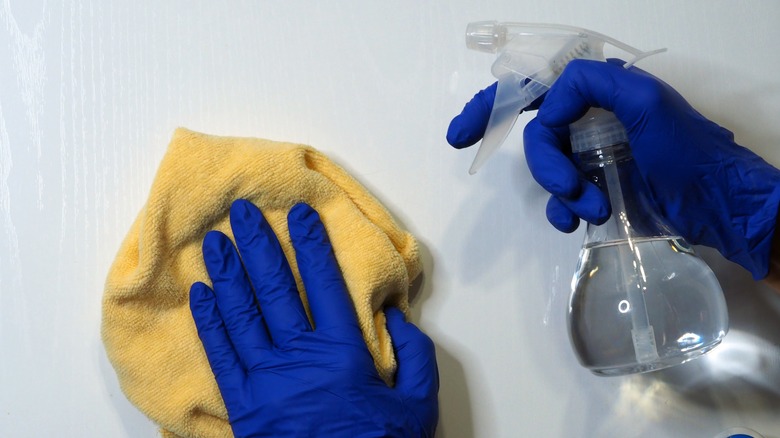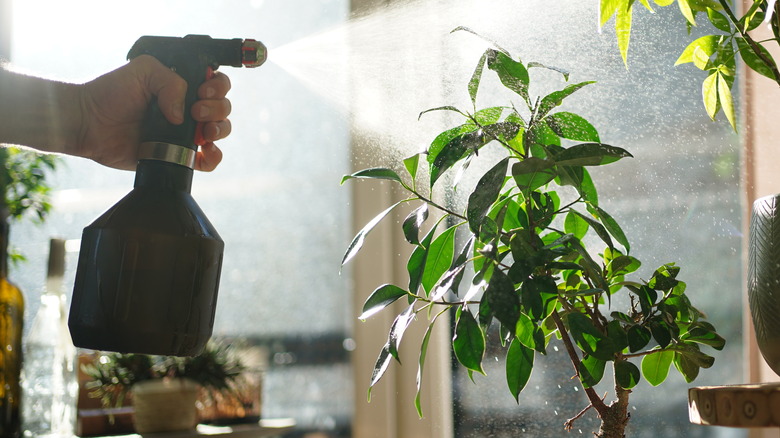The Vinegar Solution That Can Wipe Out Stink Bugs In A Pinch
Stink bugs are bothersome nuisances no matter where they are lurking. In the garden, for example, they can chow down on your plants, creating damage to leaves that makes it very difficult for plants to continue to thrive. In your home, you may not want to bother these pests because doing so creates a strong odor. Though they don't typically cause harm to people, getting rid of these bugs could be critical to making your home more comfortable. Adding vinegar and a few other at-home components is all it takes to get rid of them.
Stink bugs, formally known as brown marmorated bugs (Halyomorpha halys), can be invasive pests. They tend to seek warmth, moving into small cracks and openings in homes to make their way indoors. They don't bite people and don't harm pets. They won't do any damage to the structure of your home either.
Yet, all it takes is squishing one of them to have to deal with a secondary problem: the remaining odor. When these bugs are disturbed or smashed, they release an odor that's pungent. It's a type of warning to other bugs in the area of the threat. Getting rid of stink bug odor is problematic enough, but what if you just want to keep these bugs out of your home for good? There's no foolproof way of eradicating them all from your home, but with a few simple ingredients, you may be able to see significant improvement.
Why vinegar is a great choice for dealing with unwanted stink bugs
Vinegar is a natural powerhouse when it comes to helping to prevent illness and clean away bacteria. Vinegar's acidic makeup is strong enough to cause damage to various pests, which is why it is often used in holistic forms of insecticides. However, it is only effective when sprayed directly on the pest. Once sprayed, the stink bug will die within a matter of seconds. Vinegar is an excellent way to get rid of pests simply because of its chemical makeup.
Vinegar works like this because it is a solution of water and acetic acid, creating an acidic compound. Acetic acid is a type of volatile organic acid that creates the pungent flavor profile of vinegar as well as its strong odor. To be labeled as vinegar in the U.S., the product has to contain at least 4% acidity, which is ample enough to do away with a pest like a stink bug when you spray them with it directly.
There are other ways to get rid of stink bugs, including vacuuming them up and moving them far away from your home. You also need to seal off any entrance points (even tiny cracks in your siding) to prevent them from making their way back in. Aside from this, the best remedy for getting rid of a single stink bug or two is to invest in a vinegar and soap solution that effectively drowns them, eliminating the problem as soon as you see them (just keep a bottle ready to go!)
How to use a vinegar solution to get rid of stink bugs
The simplest solution for getting rid of stink bugs is to create a solution that combines hot water with a few drops of mild dish soap. You could stop there and apply just this to the stink bug. It will slow them down and could eventually kill them, but it's not always effective enough. However, when you add a few capfuls of vinegar to the mix, you've added enough acid that it should get rid of the bug within a matter of minutes (and typically works before they even know what's happening, therefore reducing the risk of the bug spraying its foul odor first). Combine these ingredients into a spray bottle, mix it well, aim, and spray the bug directly with it.
Note that this method is only effective when sprayed directly on the bug. It's less beneficial if you try to spray cracks or openings where they are coming in. Stink bugs are a bit too tough to kill with just the scent of the vinegar. Also important to note is that this method really is only going to be helpful when you have a small bug problem. If you have a significant infestation where there are numerous stink bugs in various areas of your home, it's time to call a professional. It can be too challenging to remove pests fully this way using a simple vinegar solution. You'll need to pinpoint their entry point, too.


